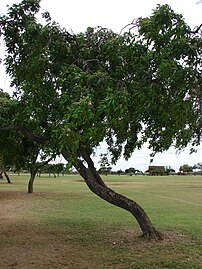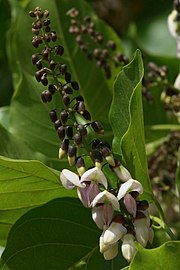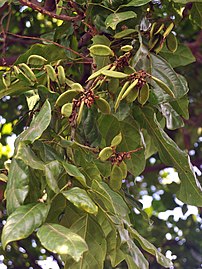Pongamia
| Pongamia | |
|---|---|

| |
| Flowers | |
| Scientific classification | |
| Kingdom: | Plantae |
| Clade: | Tracheophytes |
| Clade: | Angiosperms |
| Clade: | Eudicots |
| Clade: | Rosids |
| Order: | Fabales |
| Family: | Fabaceae |
| Subfamily: | Faboideae |
| Tribe: | Millettieae |
| Genus: | Pongamia Adans. (1763), nom. cons.
|
| Species: | P. pinnata
|
| Binomial name | |
| Pongamia pinnata | |
| Varieties[1] | |
| |
| Synonyms[1] | |
|
List
| |
Pongamia pinnata is a species of tree in the pea family, Fabaceae, native to eastern and tropical Asia, Australia, and the Pacific islands.[1][2][3][4] It is the sole species in genus Pongamia.[5] It is often known by the synonym Millettia pinnata. Its common names include Indian beech and Pongame oiltree.[3][4]
Description
Pongamia pinnata is a
Flowering generally starts after 3–4 years with small clusters of white, purple, and pink
Croppings of
Pongamia pinnata is an
-
In Oahu, Hawaii
-
Inflorescence
-
Pollen grains
-
Fruits
-
Leaves with galls
-
Pods, Rempek beach,North Lombok
Range and habitat
The species is naturally distributed in tropical and temperate Asia, from India to Japan to Thailand to
The tree is well suited to intense heat and sunlight, and its dense network of lateral roots and its thick, long
P. pinnata is now broadly distributed across India, Asia, Africa, northern Australia and the Pacific and Caribbean Islands and has been cultivated and transported since the 19th century or earlier. As a result, some literature declares M. pinnata naturalized in Africa and certain parts of the United States, while its status as naturalized or native is uncertain in other regions.[13]
Taxonomy
The species was first described as Cytisus pinnatus by
Uses
Pongamia pinnata is well-adapted to
Pongamia pinnata seeds generally contain oil (27-39%), protein (17-37%), starch (6-7%), crude fiber (5-7%), moisture (15-20%) and ash content (2-3%).
Degani et al have published a review of the applications of P. pinnata.[21] Studies have shown seedlings with tolerance to salinity levels between 12 and 19 dS/m,[22] with an ability to tolerate salinity stresses of 32.5 dS/m. [23] M. pinnata is therefore capable of using irrigation that is considered saline (>4.7 dS/m) and in soils considered saline (>4 dS/m).
Research

The seed oil has been found to be useful in diesel generators, and along with
Several unelectrified villages have used pongamia oil, simple processing techniques, and diesel generators to create their own grid systems to run water pumps and electric lighting.[27]
Research indicates potential use of P. pinnata as a food source for cattle, sheep and poultry, as its byproduct contains up to 30% protein.[28][29] A report commissioned and financed by Deutsche Gesellschaft für Internationale Zusammenarbeit (GIZ) GmbH found that the protein-rich byproduct can be free from alkaloids and therefore a dietary source of protein for humans.[10]
See also
References
- ^ a b c d Pongamia pinnata (L.) Pierre. Plants of the World Online. Retrieved 16 September 2023.
- ^ a b "Pongamia". Germplasm Resources Information Network. Agricultural Research Service, United States Department of Agriculture. Retrieved 2010-05-02.
- ^ a b "Plants profile for Millettia pinnata (pongame oiltree)". PLANTS Profile. United States Department of Agriculture. Retrieved 2012-03-30.
- ^ B.Hyland; T. Whiffen; R.A. Kerrigan. "Pongamia pinnata var. pinnata". Australian Tropical Rainforest Plants (RFK8). Centre for Plant Biodiversity Research, Australian Government. Retrieved 26 May 2021.
- ^ Pongamia Adans. Plants of the World Online. Retrieved 16 September 2023.
- ^ a b Argent, G., A. Saridan, EJF. Campbell, & P. Wilkie. "Leguminosae". Manual of The Larger and More Important Non-Dipterocarp Trees of Central Kalimantan, Indonesia. :366. Samarinda: Forest Research Institute.
- ^ a b Orwa C.; Mutua A.; Kindt R.; Jamnadass R.; Simons A. (2009). "Pongamia pinnata; Fabaceae - Papilionoideae; (L.) Pierre; pongam, karanj, karanga, kanji" (PDF). Agroforestry Database version 4.0. Retrieved 2013-11-27.
- ^ Giesen, W., S. Wulffraat, M. Zierenand & L. Scholten (2007). Mangrove Guidebook for Southeast Asia[permanent dead link]: 198-9. Bangkok :FAO and Wetlands International. ISBN 974-7946-85-8
- ^ a b c "Weed Risk Assessment : Pongamia" (PDF). Daff.qld.gov.au. Retrieved 2013-11-21.
- ^ a b c d Yogesh, Gokhale; Sharma, JV; Sharma, Priya; Burnwal, Kundan (March 2020). "CULTIVATION AND HARVESTING OF PONGAMIA PINNATA (KARANJ)" (PDF). MARKET STUDY OF THE EXISTENT AND POTENTIAL Indian Pongamia Pinnata Seeds Market: 7. Retrieved 22 July 2021.
- ^ a b c Pongamia pinnata - a nitrogen fixing tree for oilseed Archived 2016-01-17 at the Wayback Machine
- ^ a b c "Factsheet from New crops at Purdue University". Hort.purdue.edu. 1998-01-08. Retrieved 2013-09-28.
- ^ "Pongamia Risk Assessment" (PDF). Retrieved 22 July 2021.
- ^ Wendy E. Cooper, Darren M. Crayn, Frank A. Zich, Rebecca E. Miller, Melissa Harrison, Lars Nauheimer "A review of Austrocallerya and Pongamia (Leguminosae subfamily Papilionoideae) in Australia, and the description of a new monotypic genus, Ibatiria," Australian Systematic Botany, 32(4), 363-384, (29 August 2019) https://doi.org/10.1071/SB18039
- ^ "Pongamia Factsheet" (PDF). Retrieved 2013-09-28.
- PMID 21799691.
- ^ Heyne, Karel (1987). Tumbuhan Berguna Indonesia 2: 1005. Jakarta: Badan Litbang Kehutanan, Departemen Kehutanan. Dutch version: [http://archive.org/stream/denuttigeplanten02heyn#page/306/mode/2up -1916- II: 306.
- Rumpf, G.E. (1743). Herbarium Amboinense: plurimas conplectens arbores, frutices, ... Pars III: 183, Tab. cxvii. Amstelaedami :apud Franciscum Changuion, Joannem Catuffe, Hermannum Uttwerf. MDCCXLIII.
- ^ Koorders, SH. & Th. Valeton. 1895. Bijdrage tot de kennis der Boomsorten op Java. no. 2: 93. Meded. uit 's Lands Plantentuin no. XIV. Batavia: G. Kollf & co. (as Pongamia glabra.)
- ^ "Rain water harvesting by fresh water flooded forests". Scribd.com. Retrieved 2013-09-28.
- S2CID 252558634.
- S2CID 12335333.
- ^ Singh, K (1990). "Effect of soil salinity and sodicity on seedling growth and mineral composition of Pongamia pinnata and Araucaria cunninghamii". Tropical Ecology. 31 (2): 124–130 – via CAB Direct.
- PMID 15939268.
- .
- S2CID 2790680. Retrieved 23 July 2021.
- ^ "On Biodiesel". Tve.org. Archived from the original on April 26, 2012. Retrieved 2013-09-28.
- S2CID 37994181.
- ^ Heuzé V., Tran G., Delagarde R., Hassoun P., Bastianelli D., Lebas F., 2017. Karanja (Millettia pinnata). Feedipedia, a programme by INRA, CIRAD, AFZ and FAO. https://www.feedipedia.org/node/636






